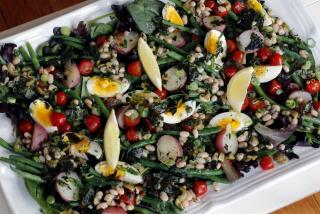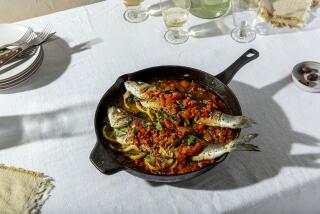The Designer Foods Project
- Share via
Call it the cancer-prevention pantry, or foods you shouldn’t leave home without. But parsley, soybeans and licorice root?
Until recently, the link between diet and cancer has rested primarily on population studies showing that some societies have more or less of certain types of cancer depending on what they eat. Now, the emphasis has shifted from people to specific foods, as researchers throughout the world are vigorously investigating the complex components in plants and animals that may help decrease--or increase--the risks of cancer.
It is a promising yet elusive search, as scientists not only must isolate the responsible substances in foods but also the mechanisms by which they work, as well as the quantities of the food or the substance needed to produce an effect.
“We know that there is some relationship between food and malignant disease,” said Daniel Nixon, vice president of detection and treatment for the American Cancer Society. “The problem is trying to tease apart the hundreds of thousands of components in foods that could be involved.”
In its groundbreaking Designer Foods project, the National Cancer Institute has begun to look at the potentially anti-carcinogenic substances in foods ranging from licorice root to flaxseed and garlic. Soybeans and umbelliferous vegetables such as parsley also are on the agenda. The research is focused on phytochemicals, which include plants’ infection fighters; researchers want to know whether they can fight cancerous cells.
There are “important frontiers in nutrition and cancer research,” said Peter Greenwald, director of the Division of Cancer Prevention and Control at the National Cancer Institute, although it may be a “number of years before we have a full picture of all the potential benefits and all the mechanisms” in food. Nevertheless, as the research is refined, there is still enough evidence to recommend a diet high in fruits, vegetables and whole grains and low in fat and calories, Greenwald said. As the American Cancer Society’s Nixon put it, with that kind of diet “you can’t go wrong.”
The National Academy of Sciences estimates that 35% of all cancer deaths are linked to diet. In addition, John Lough, spokesman for the American Institute for Cancer Research, said that perhaps 40% of all cancers in men, and 60% of all cancers in women, are associated with diet.
The strongest diet and cancer links are associated with gastrointestinal cancers, such as those of the esophagus, stomach, rectum and colon, and hormone-related ones, such as breast, endometrial and prostate cancers, Greenwald said.
The Good Guys
Until scientists come to conclusions about licorice root or parsley, here is a shopping list of the most-promising cancer preventers:
* Carrots and other yellow-orange vegetables and fruits. This is the beta-carotene connection, a link that has been studied since the 1930s, according to Caroline Wheater in her new book, “Beta Carotene: How It Can Help You to Better Health” (HarperCollins: $6.95).
Beta-carotene, the pigment also found in other yellow-orange vegetables and fruits, such as sweet potatoes, pumpkins, apricots, cantaloupes and peaches, and dark-green leafy vegetables such as spinach and broccoli, is converted to Vitamin A in the body.
But before it makes the conversion, beta-carotene appears to act as an antioxidant, stabilizing the destructive particles that make cells susceptible to cancer, according to Karen Collins, nutrition consultant for the American Institute for Cancer Research. Epidemiological studies have shown the most-promising prevention connections with high beta-carotene consumption and lung, breast and skin cancers, Collins said.
Aside from beta-carotene, researchers are beginning to look at the possible preventative effects of other carotenoids such as lycotene, found in tomatoes. Beta-carotene is only one of almost 600 types of carotenoids that give plants their color.
* Oranges and other sources of Vitamin C. Like Vitamin A, Vitamin C appears to act as an antioxidant to ward off dangerous precancerous cells. Collins said the evidence is quite good that it helps to lower stomach and esophageal cancers and halts the conversion of nitrites into carcinogenic nitrosamines. Nitrites are found in cured meats and are produced in the body by the nitrates that occur naturally in many foods.
* Cruciferous vegetables. Cabbage and its relatives such as broccoli, Brussels sprouts and cauliflower may protect against cancer of the colon, according to the NCI.
* Garlic and onions. “There’s a lot of potential” in garlic and its relatives, according to Daniel Nixon, vice president of detection and treatment for the American Cancer Society, who said researchers have identified more than 30 possible cancer preventers in the onion family.
The theory is that these substances speed up the ability of the liver to get rid of carcinogens, Nixon explained. A study in China has shown that Chinese who eat large amounts of garlic--about 10 teaspoons a day--have lower rates of stomach cancer, noted Collins.
* Fiber. This connection is based primarily on studies showing that populations that consume high-fiber diets have less colon cancer, although some researchers believe it may not be the fiber per se since high-fiber diets are generally also high in fruits and vegetables and lower in animal fat and calories.
Fiber might reduce cancer risk by either diluting colonic contents, thus limiting contact between any carcinogens that may be present, or by reducing the concentrations of promoters such as bile acids, according to David Kritchevsky, associate director of the Wistar Institute of Anatomy and Biology.
The type of fiber that looks the most protective is the insoluble fiber from whole-grain wheat. There is also evidence that wheat fiber may be protective against breast cancer, said Peter Greenwald, director of the Division of Cancer Prevention and Control at the National Cancer Institute.
The Bad Guys
Fat: This seems to have a relationship to hormonally related cancers, said Mindy Hermann, spokeswoman for the American Dietetic Assn. In the case of breast and ovarian cancers, dietary fat may play a part in raising estrogen levels in women, a risk factor for both cancers, she said.
The link with fat is also strong for colon and rectal cancers, said Peter Greenwald, director of the Division of Cancer Prevention and Control at the National Cancer Institute. Fat seems to promote the secretion of bile in the colon, and bile and fat can form chemicals that contribute to cancer development, he added.
Nevertheless, Daniel Nixon, vice president of detection and treatment for the American Cancer Society, believes the link between fat and cancer is the most controversial of all the diet-cancer connections.
* Calories: Independent of fat, which is the most calorie-dense nutrient, overconsumption of total calories seems to be involved in the development of breast and colon cancers, Nixon said. Nixon’s theory of “metabolic overload” is based on the assumption that the more calories a person consumes and the more overweight they are, the more body cells there are to divide, multiply and be susceptible to a cancer infiltration. Obesity is a risk factor for several kinds of cancer, according to the American Cancer Society.
* Alcohol: Heavy consumption contributes to mouth and throat cancers, particularly when heavy drinkers are also heavy smokers, Greenwald said. Some studies have shown an association between alcohol and breast cancer, although the evidence is debatable, he added.
* Nitrites: A sharp decline in stomach cancers in this country during the past century has been linked to vast improvements in refrigeration and food preservation, thus decreasing intake of pickled and salt-cured foods and those with added nitrites.




